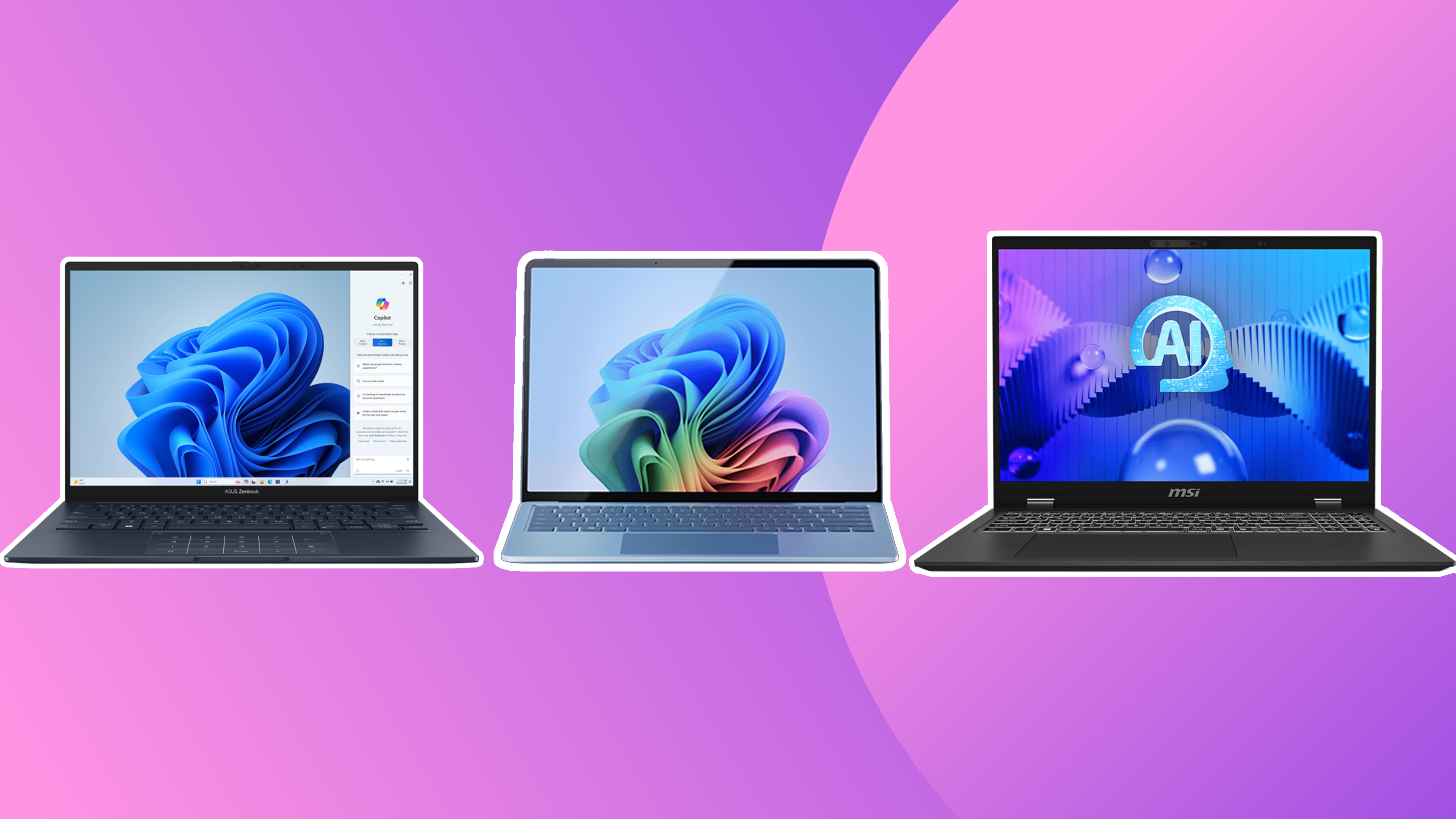
The best AI laptops are leading a new generation of portable devices that are purpose-built to harness the power of AI and machine learning capabilities directly at the hardware level. As well as the usual CPU and GPU, they come with a neural processing unit (NPU), allowing them to run large language models and generative AI tasks locally without relying on the cloud. And that can mean better performance in certain creative software.
As we mention in our article What is an AI laptop?, opting for a laptop with an NPU can help future-proof your setup as we expect more software and tools for creatives working in image and video editing will start to employ NPU-accelerated features, from upscaling to content generation and software optimisation. The best AI laptops also benefit from powerful internals in general, packing in some of the latest components for fast processing speeds and longer battery life, making them some of the best laptops for graphic design.
With that in mind, we've compared the best AI laptops on the market so far as based on our own benchmark tests and hands-on reviews, in which we put them through their paces for real-world creative tasks. Read on for our full evaluation, in which we compare the pros and cons of each and suggest who these AI laptops are most suitable for.
This article is part of our Next Gen Creative Tech week.
Quick list
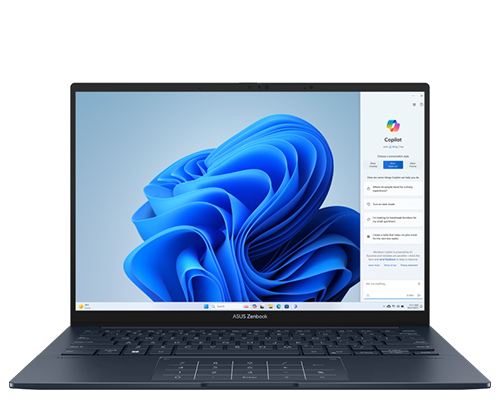
The Asus Zenbook 14 OLED (UX3405) is a lightweight yet powerful laptop with a stunning 3K OLED touchscreen display, along with Intel's 14th-generation Core Ultra processors.
Read more below
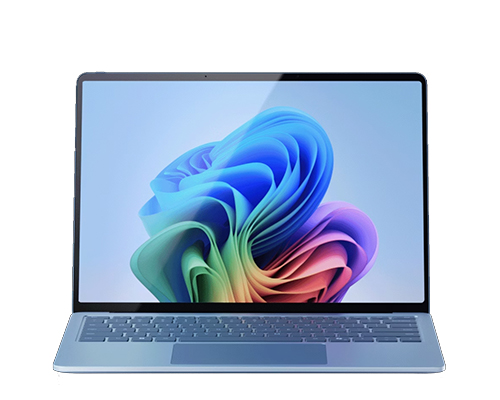
Now with the Qualcomm Snapdragon X Elite ARM64 SoC, the Surface Pro 7 is more powerful and longer lasting. A great all-rounder, it comes in two size options: 13.8- and 15-inch.
Read more below
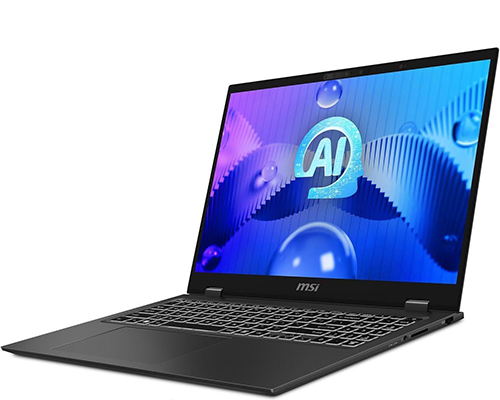
This powerful laptop gave us impressive performance in our testing, and we were impressed at how light it is for the size. With a Nvidia GPU, it promises solid performance for design and video editing.
Read more below
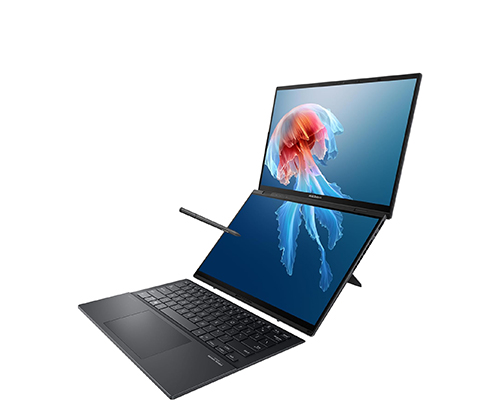
Creatives who like to work across two screens at once will love the Duo, as its main selling point is its unique and innovative design featuring two OLED touchscreens. At the same time, it packs in powerful specs too.
Read more below
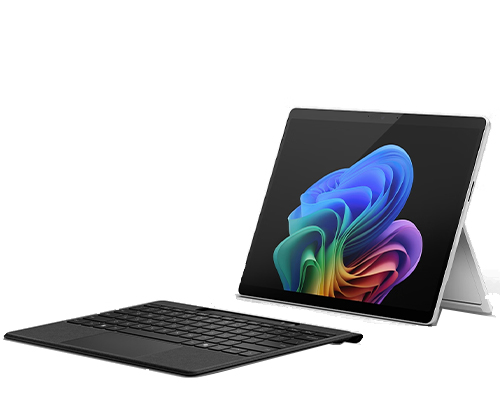
Microsoft's flagship Copilot+ PC is now powered by Snapdragon X chips for more power and efficiency, and the 13-inch 2.8K touch display now has an OLED panel for improved color and contrast. And optional keyboard can now be used detached – game changer!
Read more below
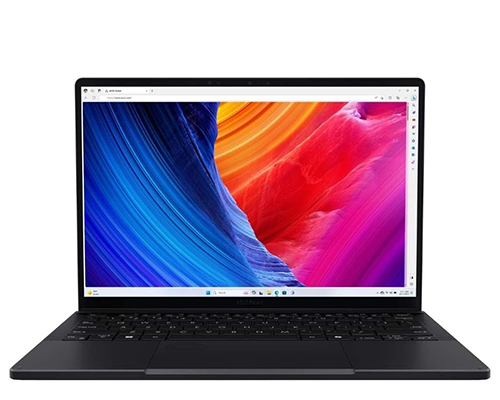
This pro option from Asus provides a lot of power, with an AMD CPU/NPU and Nvidia graphics, plus a fantastic OLED screen in a super solid and compact 13-inch device that's ideal for creatives on the go.
Read more below
The best AI laptops in full
Why you can trust Creative Bloq
The best AI laptop overall
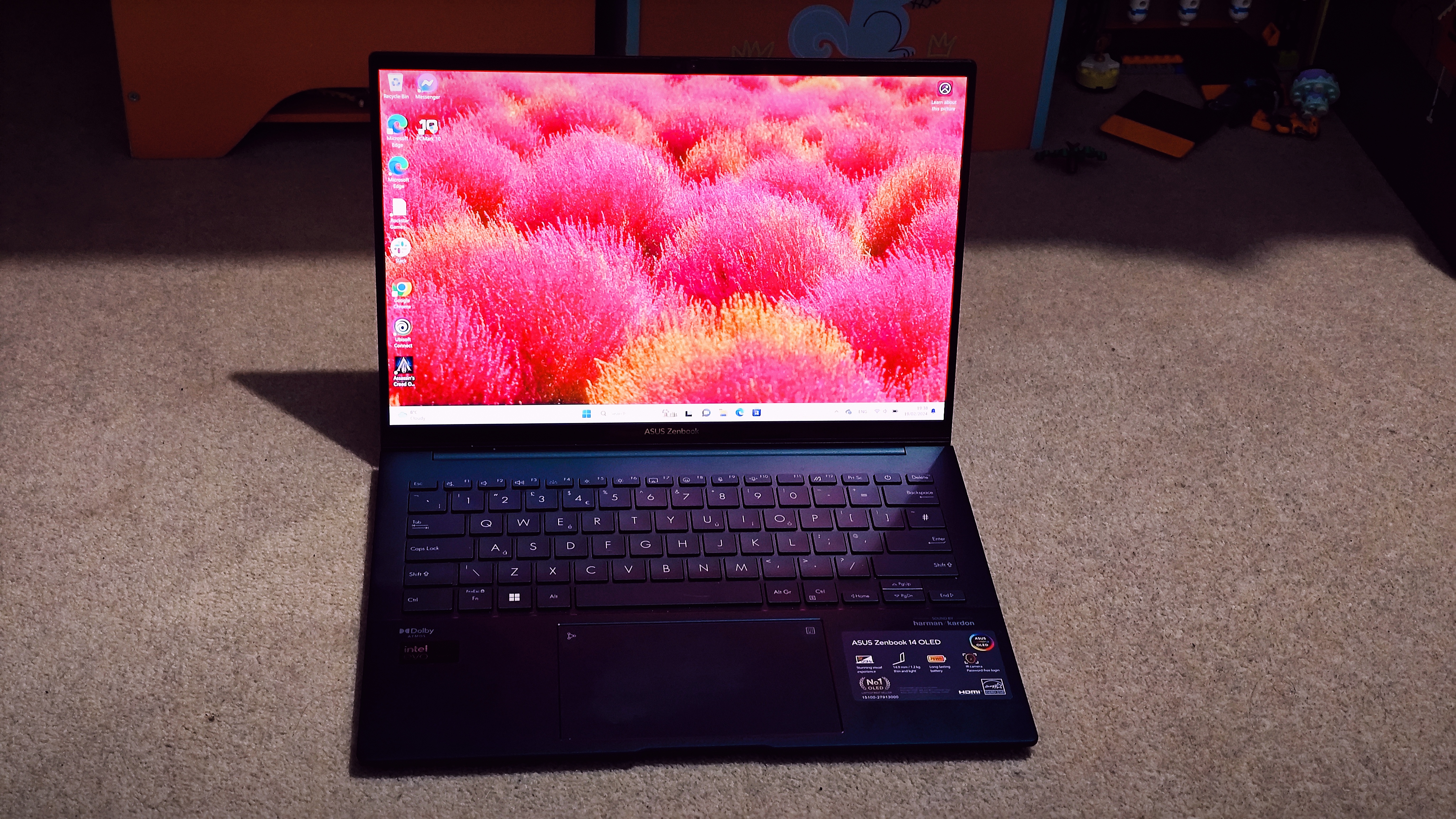
Specifications
Reasons to buy
Reasons to avoid
The Asus Zenbook 14 OLED (UX3405) is a lightweight yet powerful laptop with a stunning 3K OLED touchscreen display. And it has strong credentials as an AI laptop due to the inclusion of Intel's latest 14th-generation Core Ultra processors, nicknamed Meteor Lake.
That makes it a real powerhouse for running resource-intensive creative software such as Photoshop and After Effects. And that, when teamed with its brilliant, bright, sharp OLED touchscreen, makes it a great choice for creative professionals including designers, photographers and illustrators. Professional animators and video editors may still prefer a laptop with a separate graphics card, but it's no slouch at these tasks either.
This generation includes an AI Boost NPU designed to offload AI-related tasks, such as image generation and manipulation, from the CPU, allowing the CPU to maintain its performance for longer periods. Furthermore, the NPU assists the integrated Intel Arc graphics in delivering improved visual performance.
The Zenbook 14 OLED boasts a sleek design, a comfortable keyboard, and a responsive touchpad. It's available with various processor options, including the i5, i7, and i9 variants, paired with either 16GB or 32GB of RAM. We tested the top-of-the-line configuration, featuring the i9-185H processor and 32GB of RAM, and it delivered impressive performance, outperforming even some discrete GPU-equipped laptops in certain benchmarks.
While the port selection is limited, the Zenbook 14 OLED offers excellent value overall for its performance and features, undercutting the price of comparable MacBook models. For more details, read our full ASUS Zenbook 14 OLED review.
The best value AI laptop
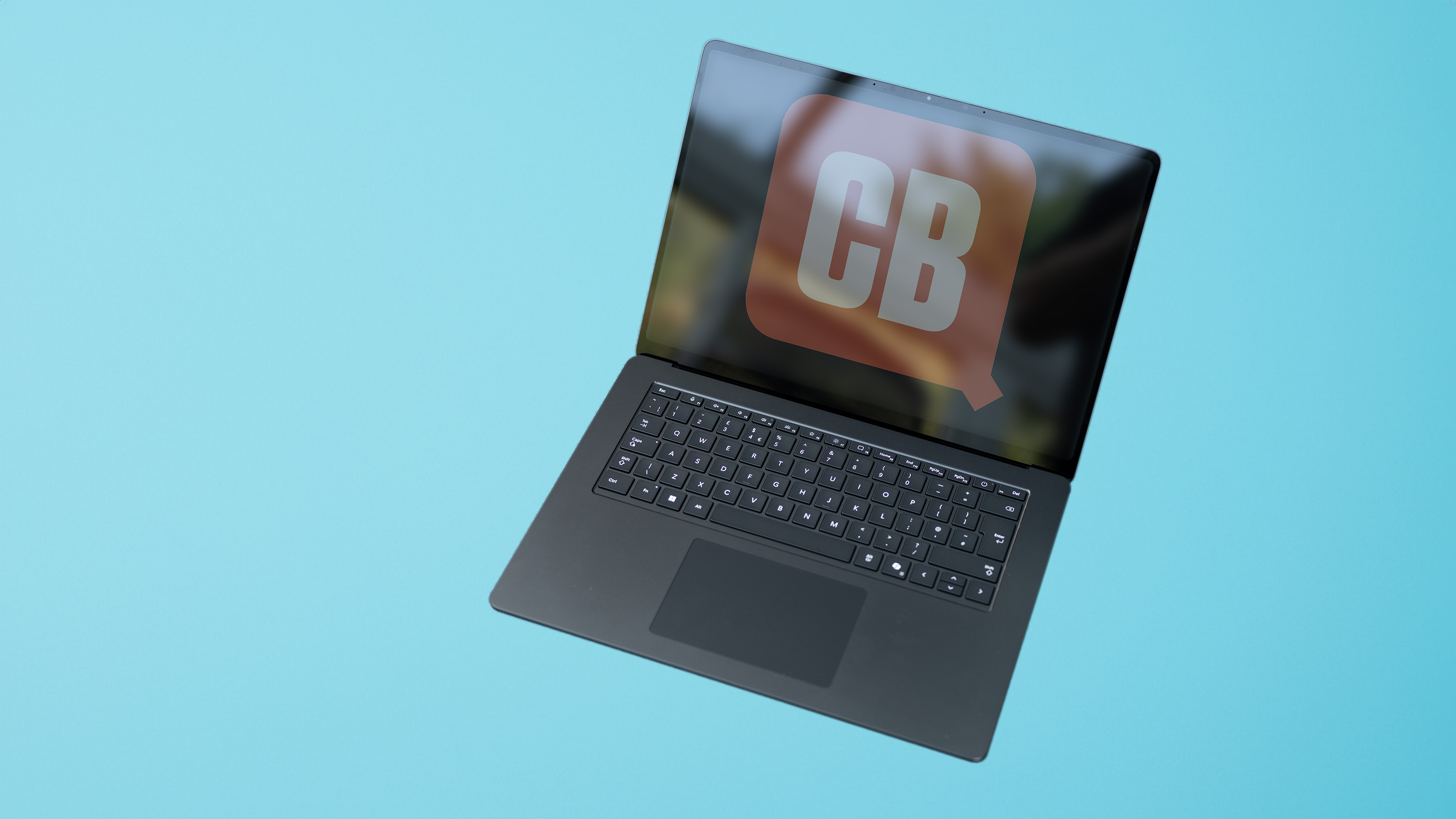
Specifications
Reasons to buy
Reasons to avoid
The Snapdragon processor and Copilot+ have made it to the Microsoft Surface Laptop, and we found the new iteration to be a real challenger to the likes of MacBooks, Lenovos and Dells and a potential all-round laptop for a lot people.
Our testing found plenty of processing power for creative apps, plus quality-of-life enhancements such as a long battery life and a well-put-together chassis as well as the inevitable AI apps that may or may not be of any use to you.
We liked the subtle branding and tapered design, plus the two USB 4 connectors, along with a USB-A, audio jack and MicroSD card reader. The screen is touch-sensitive but isn’t an OLED (see the new Surface Pro 9 below for that),. It does supports 10-bit HDR and has an sRGB mode alongside the more vague ‘vivid’ mode. We found it delivered 98% of sRGB, 72% of Adobe RGB, and 73% of P3 in our testing, while maximum brightness hit 573 nits, not too far from the claimed 600-nit level.
Read our full Microsoft Surface Laptop 7 review for more details.
Best AI laptop with a larger screen
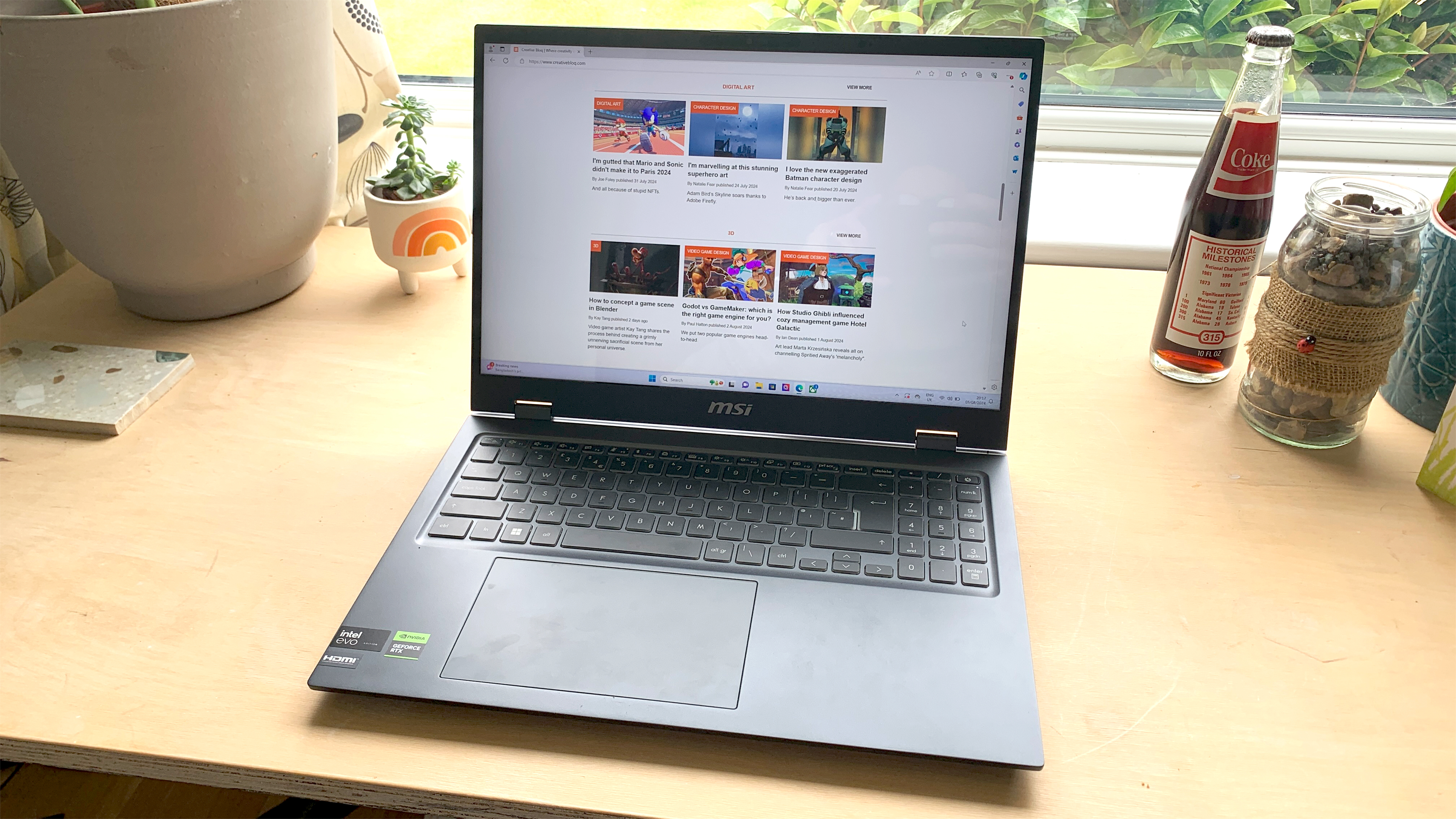
Specifications
Reasons to buy
Reasons to avoid
For a larger laptop, the MSI Prestige 16 AI is an impressive package with a solid Nvidia GPU in addition to its Intel CPU and NPU. The internals held up well in our testing, with a 10-minute, 34-second 4K video rendering in 1080p in only 6 minutes and 40 seconds. Meanwhile, the QHD+ 16-inch display boasts the increasingly popular 16:10 aspect ratio for more vertical space. We found colours to be bold and vivid with decent accuracy for creative work.
The ports are pretty much what we'd expect, with 2x USB Type-C, 1x USB Type-A and an HDMI port. There's also an SD card reader and a 3.5mm audio jack. We appreciated the full numberpad on the backlit keyboard but found the off-centre trackpad took some getting used to.
We were particularly impressed with the Prestige 16's battery life, allowing our reviewer to work for a whole day on a single charge, thanks both to the 99.9WHr battery and some clever tech that allows it to adapt to the way you work. We were also impressed with how light this is for a 16-inch AI laptop. It weighs just 1.5kg, although that does mean the build of the magnesium-aluminium alloy chassis doesn't feel the most sturdy. Well, we can't have everything.
We think this AI laptop is a great choice for content creators and video editors that want a larger display for more work space. Read our full MSI Prestige 16 AI review for more details.
Best AI laptop for dual screen working
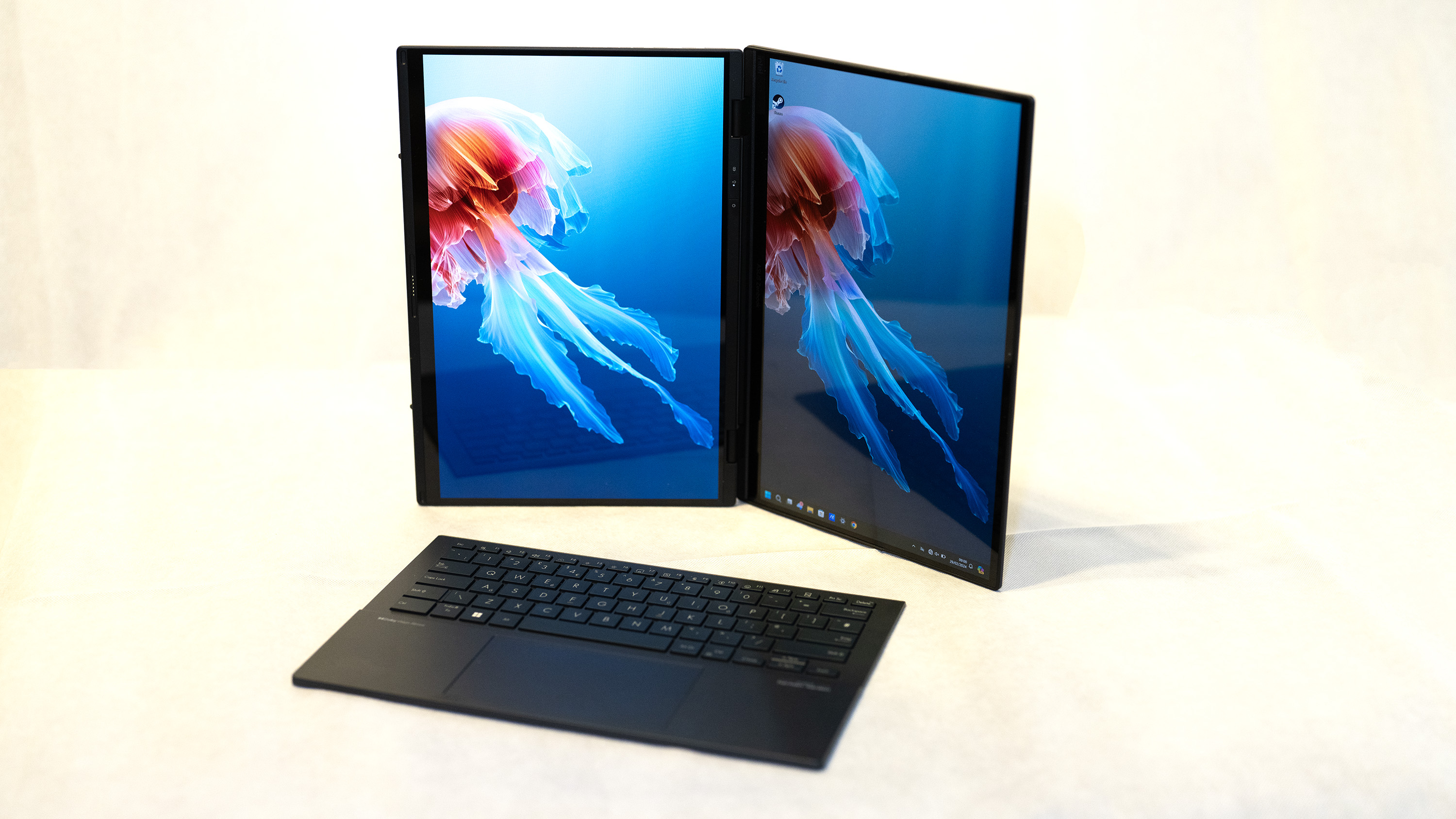
Specifications
Reasons to buy
Reasons to avoid
Processor performance isn't the only thing you should look for in a laptop. It's also worth thinking about how you tend to work. For instance, many creative professionals like to work across two screens simultaneously, so you don't have to spend so much time opening, closing and resizing windows. And if that's you, then why not get a laptop with two screens?
This is the Duo's main selling point, as its unique and innovative design features not one but two OLED touchscreens. The main screen is complemented by a secondary screen below the keyboard that can be positioned in different orientations. When you're doing tasks like cutting and pasting from a word doc into a poster design, or pulling together multiple photos into a collage, this dual-screen setup makes everything easier, by essentially providing a portable dual-monitor setup without needing an external display.
At the same time, the Zenbook Duo OLED packs powerful specs including an Intel Core Ultra 9 CPU, 32GB RAM, and ample storage of 32GB. The build quality, keyboard, trackpad, and included stylus are all excellent, and performance in our tests was excellent, with benchmark scores comparable to desktop-class processors.
Impressively, the laptop offered over 12 hours of battery life when using just the main screen, although using both would drain the power a lot faster. And while this laptop is very expensive, we reckon it's worth the cost given the innovative design and high performance for creative and productivity work on the go.
Overall this is remarkable, futuristic laptop that pushes the boundaries of what a portable computing experience can offer. For more details, read our full ASUS Zenbook Duo OLED review.
The best 2-in-1 AI laptop
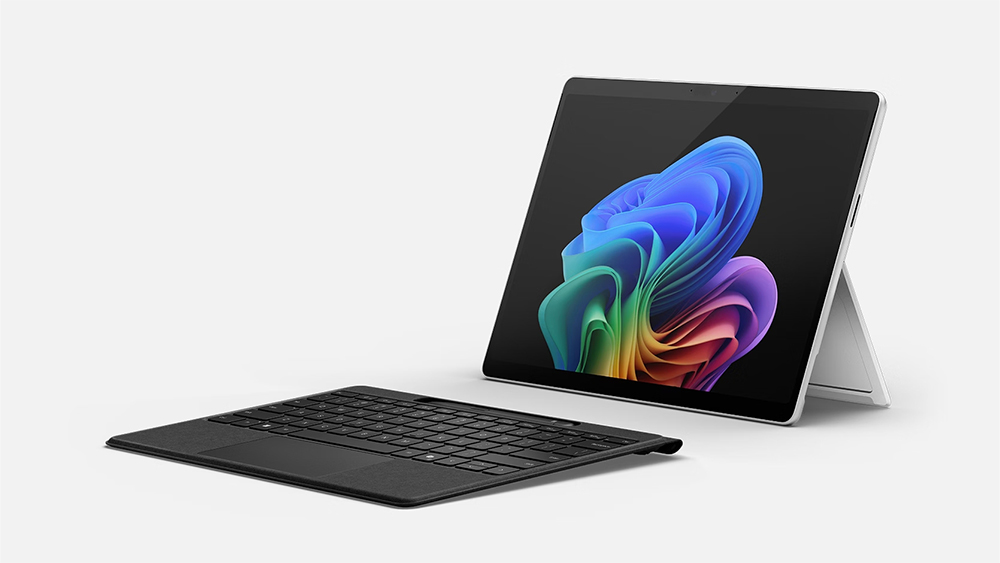
05. Microsoft Surface Pro (11th generation, 2024)
Our expert review:
Specifications
Reasons to buy
Reasons to avoid
We think the Surface Pro 11, Microsoft's flagship Copilot+ PC, is the best AI laptop for those that want the power of a laptop as well as the portable convenience of a tablet. It's essentially a tablet that runs Windows, allowing you to use desktop apps, but you can add Microsoft's Type Cover to turn it into a compact and portable laptop.
The new-generation Surface Pro has the same sleek, slim design as previous models, with a sturdy kick stand behind the tablet. But there are significant upgrades when it comes to specs and performance. The new ARM-based Snapdragon X chips add an NPU to power future Windows 11 AI features.
Some of this is more potential for the future than of practical use today since some AI features remain hypothetical (for now the Copilot button the keyboard is fairly useless), but even beyond the potential AI capabilities, we found improved general performance – the Snapdragon X Elite configuration did well on our Handbrake video editing test. Battery life is excellent for a Windows device, giving us just over 12 hours of internet browsing at 150 nits brightness. That compares to around 15 hours when we tested the latest MacBook Air, one of the best laptops for battery life.
This is also the first Surface Pro to have an OLED display, and the improved colour and contrast is notable. And a real game changing feature is that the optional keyboard, Microsoft's Type Cover, is now detachable, making it much more practical to get the most out of the possibilities of the 2-in-1 laptop-cum-tablet format. In tablet mode, it's a comfortable weight to hold, and the touch screen is responsive for drawing.
And the downside? Like its predecessors, the newest Surface Pro requires you to buy the Type Cover and the Surface Slim stylus separately if you want to really get the most out of it and be able to use it like a laptop or for drawing. That means the cost can very soon add up. Also be aware that some games and some creative software programs are not yet available for ARM-based chips. However, Adobe Photoshop and Adobe Lightroom are already Arm64 native and Adobe says more of its software will be soon.
The best AI laptop for travel
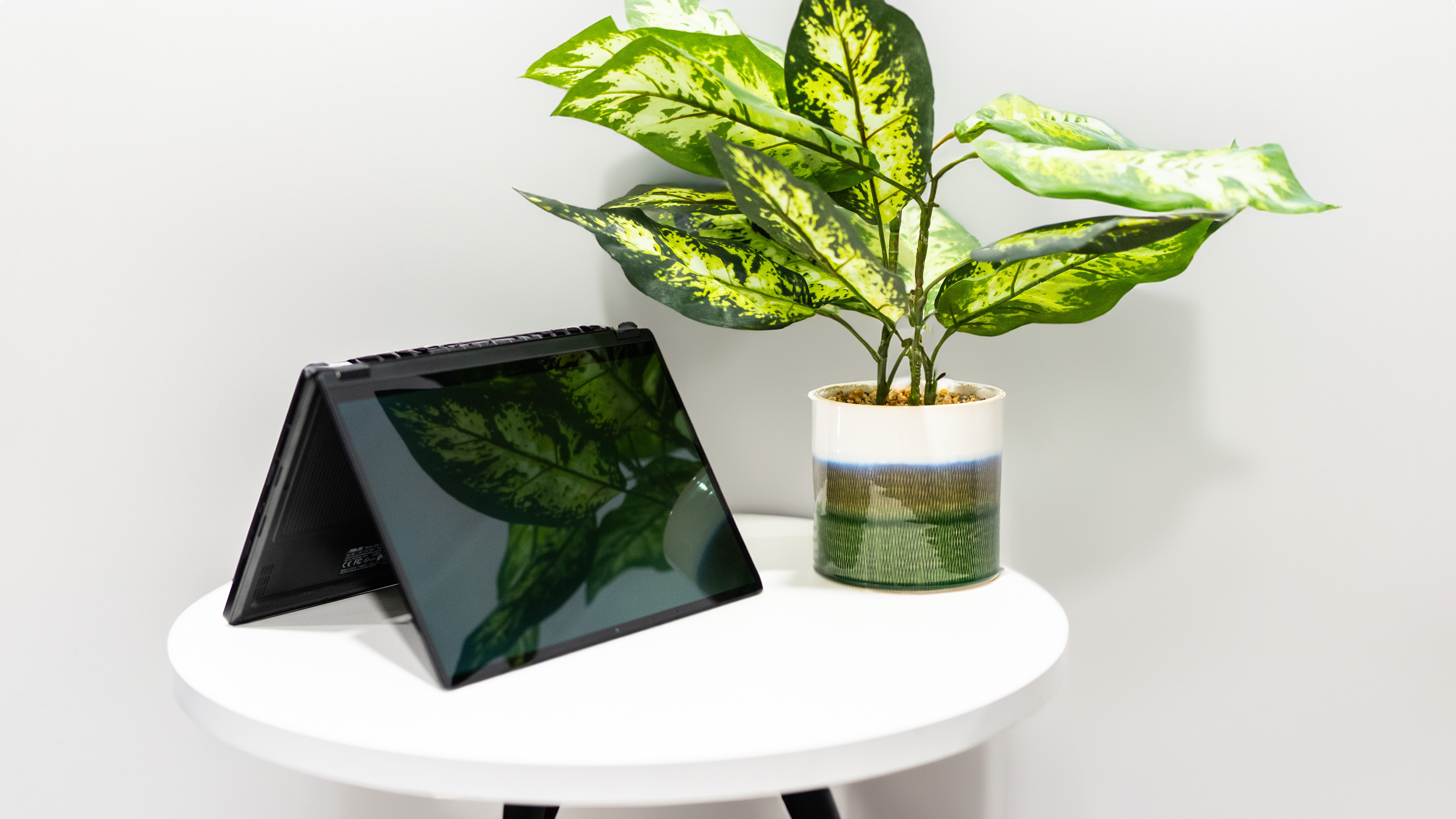
Specifications
Reasons to buy
Reasons to avoid
The Asus ProArt PX13 may be compact, but we found it to be a hugely powerful device with specs that will impress creative pros who need a laptop for travel. It packs in beefy internals from AMD and Nvidia and an OLED screen that's as excellent as we've come to expect from Asus's ProArt range, covering 96% of Adobe RGB and 97% P3, although a refresh rate of just 60hz means motion designers may want to use an external screen when possible.
As a Windows AI laptop, it sports a Copilot button on the keyboard. The design also manages to fit Asus's handy dial on the trackpad. We found that the 2-in-1 format provides a lot of versatility. The touchscreen display is comfortable to use propped up in tent mode. It can also be used handheld gripped from any direction, but we found that the touchpad wouldn't click if we held it by the corner – a minor issue.
There are two USB-C ports, one Type-A, a full-size HDMI 2.1 and a Micro SD card reader, which is a lot more connectivity options than you tend to get on the compact Surface Pro 9 above. As for performance, the Nvidia GeForce RTX 4070 made light work of video workflows in our testing, while the Ryzen AI 9 chip flew through our benchmark tests, showing it to be a powerful competitors for Intel's best silicon.
At two grand, this is an expensive for a 13in laptop, but we found the design and performance hard to falt, and a stylus comes included in the box. There's even an option of a dedicated backpack designed for the device, a shore signal of the portability that this AI laptop has been designed for.
See our full Asus ProArt PX13 review for more on our experience with this AI laptop.
Best AI laptop for gaming

07. Alienware m16 R2
Our expert review:
Specifications
Reasons to buy
Reasons to avoid
The Alienware m16 R2 is a gaming laptop that attempts to bridge the gap between gaming performance and productivity using AI hardware. With a relatively subdued aesthetic compared to typical gaming laptops, under the hood it packs Intel's new Meteor Lake Core Ultra processor which integrates a Neural Processing Unit (NPU) aimed at accelerating AI tasks.
Paired with NVIDIA's RTX 40-series GPUs, it delivers solid gaming performance, capable of running most modern titles well over 60fps at 1080p resolution. The 240Hz refresh rate and 3ms response time display ensures a smooth gaming experience. And general productivity performance is also reliable, handling tasks like web browsing and video editing with ease.
This laptop also features a 180-degree hinge for laying the display completely flat, comes with a unique "Stealth" mode allows switching to white keyboard backlighting and reduced performance for better battery life during non-gaming usage scenarios. Another standout aspect is the spacious keyboard deck and thick keycaps, providing an enjoyable typing experience. On the downside, battery life is disappointingly short, lasting only around six hours in general use.
The best MacBook Pro alternatve

08. ASUS ROG Zephyrus G14
Our expert review:
Specifications
Reasons to buy
Reasons to avoid
The new Asus ROG Zephyrus G14 (2024) represents a major refinement over its predecessor, positioning it as a compelling all-around laptop that could rival the MacBook Pro.
One of the most notable improvements is the gorgeous aluminum unibody redesign, which gives the G14 a sleek, premium look and feel. It's also thinner and lighter than before. But the star of the show is the stunning 14-inch 3K (2880 x 1800) OLED display, with its 120Hz refresh rate, 0.2ms response time, and G-Sync support, it offers vivid colours, deep contrast, and smooth motion – good for gaming and creative work alike.
Under the hood, the G14 can be configured with up to an AMD Ryzen 9 8945HS CPU and Nvidia RTX 4070 GPU. There's no separate NPU, but one that's integrated into the CPU. This helps it achieve long battery life and impressive overall performance, making it a strong alternative to Apple's MacBook Pro for gaming and creative work.
How to choose an AI laptop
When choosing an AI laptop, there are a number of factors to take into account. Most importantly, consider the AI processor: look for dedicated AI chips/accelerators from companies like Intel, AMD and NVIDIA. Also look at RAM and storage. Prioritize higher RAM of 16GB+ and fast SSD storage as AI workloads are storage intensive. Also pay attention to battery life: AI processing can drain batteries quickly, so look for large battery capacities.
How we test AI laptops
To choose the best AI laptops, we've drawn on the knowledge of our expert reviewers, who have years of experience testing laptops. Our testing methodology involves a comprehensive evaluation of build quality, design, performance benchmarks, and real-world usage scenarios. Build quality is scrutinised by examining the materials used, assessing the feel and durability over extended periods of use.
We also evaluate the laptop's design based on its suitability for the intended use-case, ergonomics, portabilityand overall usability. Displays undergo rigorous testing for tone, brightness, clarity and colour accuracy, and we use keyboards, touchpads and stylus input extensively to judge their performance. For more details, read how we test laptops.
FAQs
What is an AI laptop?
An AI laptop is a portable computer with hardware specifically designed to run AI tasks quickly and efficiently. This allows the laptop to perform tasks like voice recognition, facial recognition, predictive analytics, and machine learning right on the device without relying on cloud-based AI services. An AI laptop usually has a dedicated AI processor to accelerate these AI workloads.
What are the benefits of an AI laptop?
The main benefits of using an AI laptop include enhanced security, improved productivity, on-device AI processing and future-proofing. AI can help secure the laptop through features like facial login, malware detection, and encryption. It can automate repetitive tasks, provide intelligent suggestions, and enable seamless voice controls, boosting productivity.
Since AI processing happens locally, there is reduced latency and fewer privacy/security risks from cloud connectivity. As AI becomes more ubiquitous, an AI laptop will ensure you have the hardware to take advantage of new AI capabilities since more developers are working on NPU-accelerated tools and NPU-accelerated software optimisation. For now, specific tools that use NPU acceleration include DaVinci Resolve’s magic masking and NeuralMix in djay Pro.
Do I need a special operating system for an AI laptop?
No, probably not. Most AI laptops come with a standard operating system like Windows 11 pre-installed. However, if you're working in AI yourself, you may prefer to install a different operating system that is specifically designed for AI development, such as Ubuntu with machine learning libraries pre-installed.
Daily design news, reviews, how-tos and more, as picked by the editors.

Tom May is an award-winning journalist specialising in art, design, photography and technology. His latest book, The 50 Greatest Designers (Arcturus Publishing), was published this June. He's also author of Great TED Talks: Creativity (Pavilion Books). Tom was previously editor of Professional Photography magazine, associate editor at Creative Bloq, and deputy editor at net magazine.
- Joe FoleyFreelance journalist and editor
